Exploring the Role of Donor–Acceptor Interactions in Phenothiazine Organic Dyes and Their Implications for Quasi-Solid-State Dye-Sensitized Solar Cells
Abstract
1. Introduction
2. Materials and Methods
2.1. Assembly and Characterization of DSSCs
2.2. Stability Study of DSSCs
3. Results
3.1. Chemical Structures of the Dyes
3.2. J–V Characteristics of DSSCs with Phenothiazine Dyes and DMPII-Based Liquid and Quasi-Solid-State Electrolytes
3.3. DSSCs with 2-LBH-100 Phenothiazine Dye and with and Without PVDF-HFP with Different Molecular Weights in DMPII Electrolyte
3.3.1. UV–Vis Absorption and IPCE Spectra
3.3.2. Stability Study
3.4. DSSCs with 2-LBH-44 Phenothiazine Dye and with and Without PVDF-HFP with Different Molecular Weights in DMPII Electrolyte
3.4.1. UV–Vis Absorption and IPCE Spectra
3.4.2. Stability Study
3.5. DSSCs with 2-Ryu-4 Phenothiazine Dye and with and Without PVDF-HFP with Different Molecular Weights in DMPII Electrolyte
3.5.1. UV–Vis Absorption and IPCE Spectra
3.5.2. Stability Study
4. Discussion
5. Conclusions
Author Contributions
Funding
Data Availability Statement
Acknowledgments
Conflicts of Interest
References
- O’Regan, B.; Grätzel, M. A low-cost, high-efficiency solar cell based on dye-sensitized colloidal TiO2 films. Nature 1991, 353, 737–740. [Google Scholar] [CrossRef]
- Saidi, N.M.; Omar, F.S.; Numan, A.; Apperley, D.C.; Algaradah, M.M.; Kasi, R.; Avestro, A.-J.; Subramaniam, R.T. Enhancing the efficiency of a dye-sensitized solar cell based on a metal oxide nanocomposite gel polymer electrolyte. ACS Appl. Mater. Interfaces 2019, 11, 30185–30196. [Google Scholar] [CrossRef]
- Pang, H.-W.; Yu, H.-F.; Huang, Y.-J.; Li, C.-T.; Ho, K.-C. Electrospun membranes of imidazole-grafted PVDF-HFP polymeric ionic liquids for highly efficient quasi-solid-state dye-sensitized solar cells. J. Mater. Chem. A 2018, 6, 14215–14223. [Google Scholar] [CrossRef]
- Li, C.; Xin, C.; Xu, L.; Zhong, Y.; Wu, W. Components control for high-voltage quasi-solid state dye-sensitized solar cells based on two-phase polymer gel electrolyte. Sol. Energy 2019, 181, 130–136. [Google Scholar] [CrossRef]
- Day, J.; Senthilarasu, S.; Mallick, T.K. Improving spectral modification for applications in solar cells: A review. Renew. Energy 2019, 132, 186–205. [Google Scholar] [CrossRef]
- Agarwal, R.; Vyas, Y.; Chundawat, P.; Dharmendra; Ameta, C. Outdoor performance and stability assessment of dye-sensitized solar cells (DSSCs). In Solar Radiation—Measurement, Modeling and Forecasting Techniques for Photovoltaic Solar Energy Applications; Aghaei, M., Ed.; IntechOpen: London, UK, 2022; pp. 1–21. [Google Scholar]
- Zhang, D.; Stojanovic, M.; Ren, Y.; Cao, Y.; Eickemeyer, F.T.; Socie, E.; Vlachopoulos, N.; Moser, J.-E.; Zakeeruddin, S.M.; Hagfeldt, A.; et al. A molecular photosensitizer achieves a Voc of 1.24 V enabling highly efficient and stable dye-sensitized solar cells with copper(II/I)-based electrolyte. Nat. Commun. 2021, 12, 1777. [Google Scholar] [CrossRef] [PubMed]
- Sharma, K.; Sharma, V.; Sharma, S.S. Dye-sensitized solar cells: Fundamentals and current status. Nanoscale Res. Lett. 2018, 13, 381. [Google Scholar] [CrossRef]
- Al-Busaidi, I.J.; Haque, A.; Al Rasbi, N.K.; Khan, M.S. Phenothiazine-based derivatives for optoelectronic applications: A review. Synth. Met. 2019, 257, 116189. [Google Scholar] [CrossRef]
- Almenningen, D.M.; Haga, B.S.; Hansen, H.E.; Buene, A.F.; Hoff, B.H.; Gautun, O.R. Adamantyl side chains as anti-aggregating moieties in dyes for dye-sensitized solar cells. Chem. Eur. J. 2022, 28, e202201726. [Google Scholar] [CrossRef]
- Li, S.; He, J.; Jiang, H.; Mei, S.; Hu, Z.; Kong, X.; Yang, M.; Wu, Y.; Zhang, S.; Tan, H. Comparative studies on the structure–performance relationships of phenothiazine-based organic dyes for dye-sensitized solar cells. ACS Omega 2021, 6, 6817–6823. [Google Scholar] [CrossRef]
- Santos, H.F.; Dos Santos, C.G.; Nascimento, O.R.; Reis, A.K.C.A.; Lanfredi, A.J.C.; De Oliveira, H.P.M.; Nantes-Cardoso, I.L. Charge separation of photosensitized phenothiazines for applications in catalysis and nanotechnology. Dyes Pigm. 2020, 177, 108314. [Google Scholar] [CrossRef]
- Gong, P.; An, L.; Tong, J.; Liu, X.; Liang, Z.; Li, J. Design of A-D-A-type organic third-order nonlinear optical materials based on benzodithiophene: A DFT study. Nanomaterials 2022, 12, 3700. [Google Scholar] [CrossRef]
- Choi, H.; Paek, S.; Lim, K.; Kim, C.; Kang, M.-S.; Song, K.; Ko, J. Molecular engineering of organic sensitizers for highly efficient gel-state dye-sensitized solar cells. J. Mater. Chem. A 2013, 1, 8226–8233. [Google Scholar] [CrossRef]
- Afre, R.A.; Ryu, K.Y.; Shin, W.S.; Pugliese, D. Comparative study of quasi-solid-state dye-sensitized solar cells using Z907, N719, photoactive phenothiazine dyes and PVDF-HFP gel polymer electrolytes with different molecular weights. Photonics 2024, 11, 760. [Google Scholar] [CrossRef]
- Yang, X.; Zhao, J.; Wang, L.; Tian, J.; Sun, L. Phenothiazine derivatives-based D–π–A and D–A–π–A organic dyes for dye-sensitized solar cells. RSC Adv. 2014, 4, 24377–24383. [Google Scholar] [CrossRef]
- Wu, Y.; Zhu, W. Organic sensitizers from D–π–A to D–A–π–A: Effect of the internal electron-withdrawing units on molecular absorption, energy levels and photovoltaic performances. Chem. Soc. Rev. 2013, 42, 2039–2058. [Google Scholar] [CrossRef] [PubMed]
- Mishra, A.; Fischer, M.K.R.; Bäuerle, P. Metal-free organic dyes for dye-sensitized solar cells: From structure: Property relationships to design rules. Angew. Chem. Int. Ed. 2009, 48, 2474–2499. [Google Scholar] [CrossRef]
- Ye, M.; Wen, X.; Wang, M.; Iocozzia, J.; Zhang, N.; Lin, C.; Lin, Z. Recent advances in dye-sensitized solar cells: From photoanodes, sensitizers, and electrolytes to counter electrodes. Mater. Today 2015, 18, 155–162. [Google Scholar] [CrossRef]
- Lee, K.-M.; Suryanarayanan, V.; Ho, K.-C. A photo-physical and electrochemical impedance spectroscopy study on the quasi-solid state dye-sensitized solar cells based on poly(vinylidene fluoride-co-hexafluoropropylene). J. Power Sources 2008, 185, 1605–1612. [Google Scholar] [CrossRef]
- Duvva, N.; Eom, Y.K.; Reddy, G.; Schanze, K.S.; Giribabu, L. Bulky phenanthroimidazole–phenothiazine D−π–A based organic sensitizers for application in efficient dye-sensitized solar cells. ACS Appl. Energy Mater. 2020, 3, 6758–6767. [Google Scholar] [CrossRef]
- Masud; Kim, K.M.; Kim, H.K. Polymer gel electrolytes based on PEG-functionalized ABA triblock copolymers for quasi-solid-state dye-sensitized solar cells: Molecular engineering and key factors. ACS Appl. Mater. Interfaces 2020, 12, 42067–42080. [Google Scholar] [CrossRef]
- Han, F.; Wang, Y.; Wan, Z.; Jia, C.; Luo, J.; Yao, X. Enhanced photovoltaic performances of dye-sensitized solar cells sensitized with D-D-π-A phenothiazine-based dyes. Synth. Met. 2016, 221, 95–102. [Google Scholar] [CrossRef]
- Sharma, G.D.; Suresh, P.; Roy, M.S.; Mikroyannidis, J.A. Effect of surface modification of TiO2 on the photovoltaic performance of the quasi solid state dye sensitized solar cells using a benzothiadiazole-based dye. J. Power Sources 2010, 195, 3011–3016. [Google Scholar] [CrossRef]
- Shen, S.-Y.; Dong, R.-X.; Shih, P.-T.; Ramamurthy, V.; Lin, J.-J.; Ho, K.-C. Novel polymer gel electrolyte with organic solvents for quasi-solid-state dye-sensitized solar cells. ACS Appl. Mater. Interfaces 2014, 6, 18489–18496. [Google Scholar] [CrossRef] [PubMed]
- Bandara, T.M.W.J.; Weerasinghe, A.M.J.S.; Dissanayake, M.A.K.L.; Senadeera, G.K.R.; Furlani, M.; Albinsson, I.; Mellander, B.-E. Characterization of poly (vinylidene fluoride-co-hexafluoropropylene) (PVdF-HFP) nanofiber membrane based quasi solid electrolytes and their application in a dye sensitized solar cell. Electrochim. Acta 2018, 266, 276–283. [Google Scholar] [CrossRef]
- Cao, Y.; Saygili, Y.; Ummadisingu, A.; Teuscher, J.; Luo, J.; Pellet, N.; Giordano, F.; Zakeeruddin, S.M.; Moser, J.-E.; Freitag, M.; et al. 11% efficiency solid-state dye-sensitized solar cells with copper (II/I) hole transport materials. Nat. Commun. 2017, 8, 15390. [Google Scholar] [CrossRef]
- Cheng, Y.; Yang, G.; Jiang, H.; Zhao, S.; Liu, Q.; Xie, Y. Organic sensitizers with extended conjugation frameworks as cosensitizers of porphyrins for developing efficient dye-sensitized solar cells. ACS Appl. Mater. Interfaces 2018, 10, 38880–38891. [Google Scholar] [CrossRef] [PubMed]
- Ito, S. Investigation of dyes for dye-sensitized solar cells: Ruthenium-complex dyes, metal-free dyes, metal-complex porphyrin dyes and natural dyes. In Solar Cells—Dye-Sensitized Devices, 1st ed.; Kosyachenko, L.A., Ed.; IntechOpen: London, UK, 2011; pp. 19–48. [Google Scholar]
- Law, C.H.; Pathirana, S.C.; Li, X.; Anderson, A.Y.; Barnes, P.R.F.; Listorti, A.; Ghaddar, T.H.; O’Regan, B.C. Water-based electrolytes for dye-sensitized solar cells. Adv. Mater. 2010, 22, 4505–4509. [Google Scholar] [CrossRef]
- Roy, M.S.; Deol, Y.S.; Kumar, M.; Prasad, N.; Janu, Y. Dye-sensitized solar cells for solar energy harvesting. AIP Conf. Proc. 2011, 1391, 46–49. [Google Scholar]
- Gong, J.; Sumathy, K.; Qiao, Q.; Zhou, Z. Review on dye-sensitized solar cells (DSSCs): Advanced techniques and research trends. Renew. Sustain. Energy Rev. 2017, 68, 234–246. [Google Scholar] [CrossRef]
- Li, J.; Shi, Y. Electron Transport and Recombination in TiO2 Nanofiber Dye Sensitized Solar Cell. In Proceedings of the ASME 2011 International Mechanical Engineering Congress and Exposition, Denver, CO, USA, 11–17 November 2011. [Google Scholar]
- Cha, S.Y.; Lee, Y.-G.; Kang, M.-S.; Kang, Y.S. Correlation between ionic conductivity and cell performance in solid-state dye-sensitized solar cells employing polymer electrolyte. J. Photochem. Photobiol. 2010, 211, 193–196. [Google Scholar] [CrossRef]
- Kim, J.Y.; Kim, T.H.; Kim, D.Y.; Park, N.-G.; Ahn, K.-D. Novel thixotropic gel electrolytes based on dicationic bis-imidazolium salts for quasi-solid-state dye-sensitized solar cells. J. Power Sources 2008, 175, 692–697. [Google Scholar] [CrossRef]

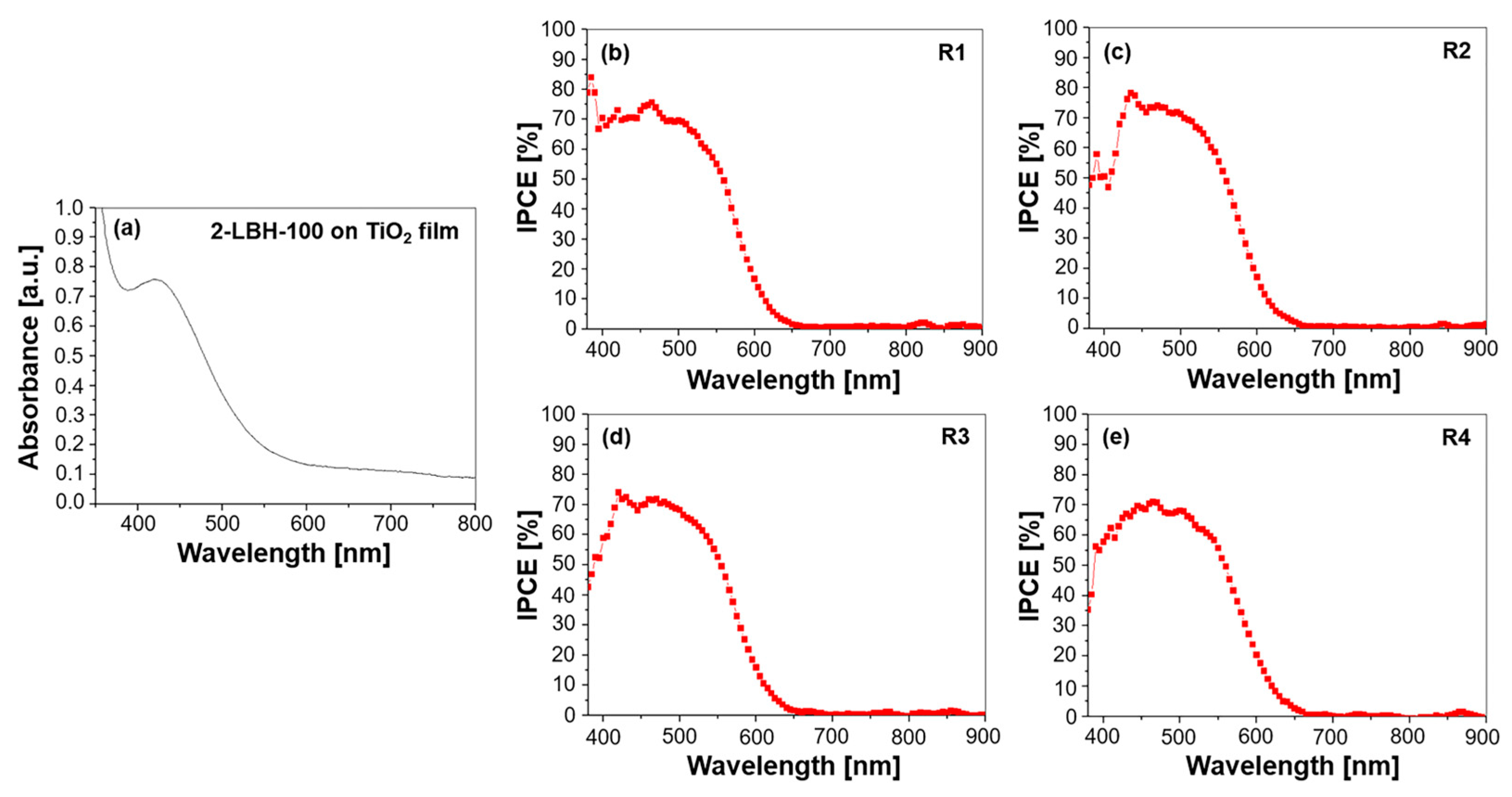

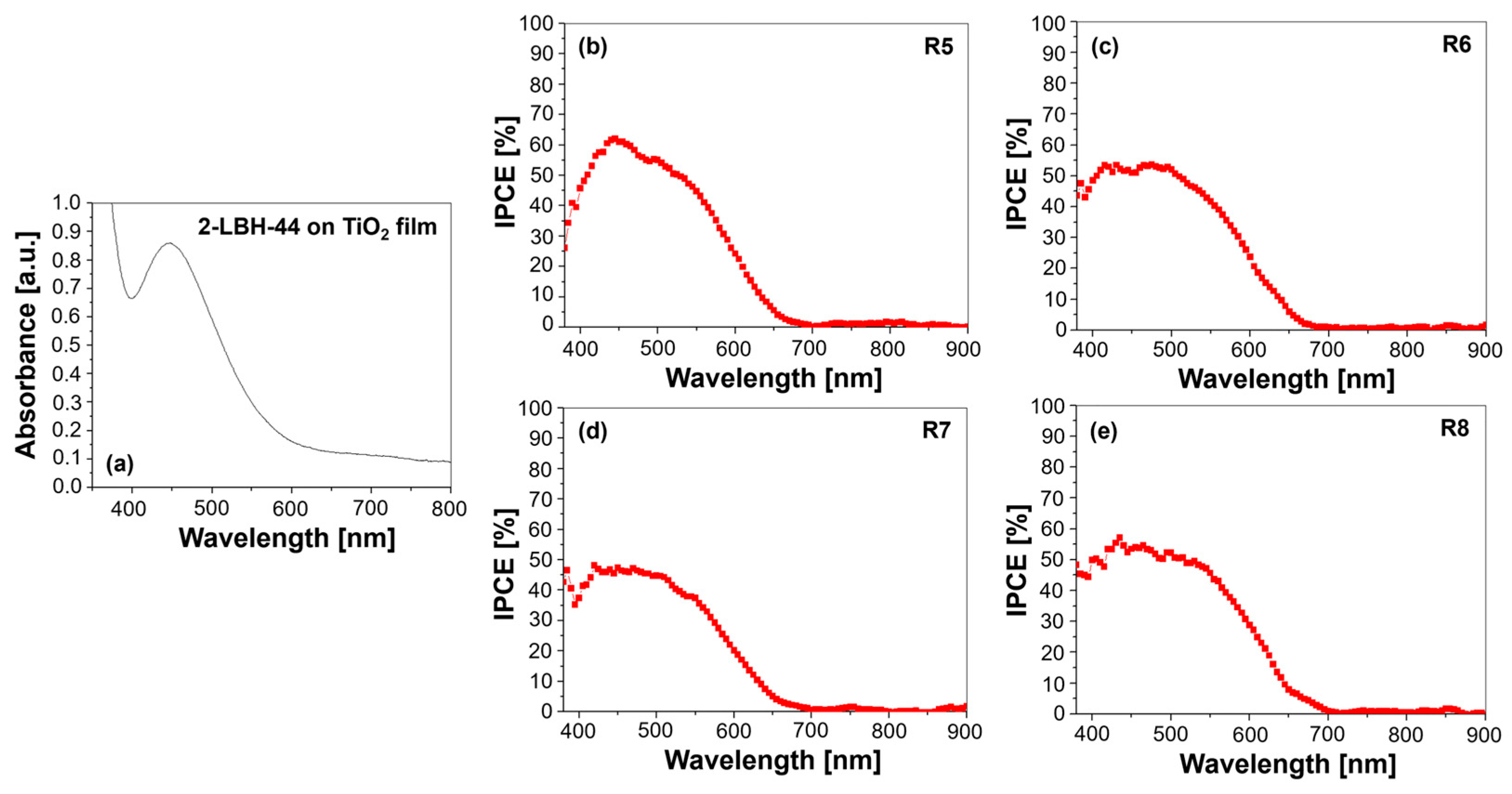
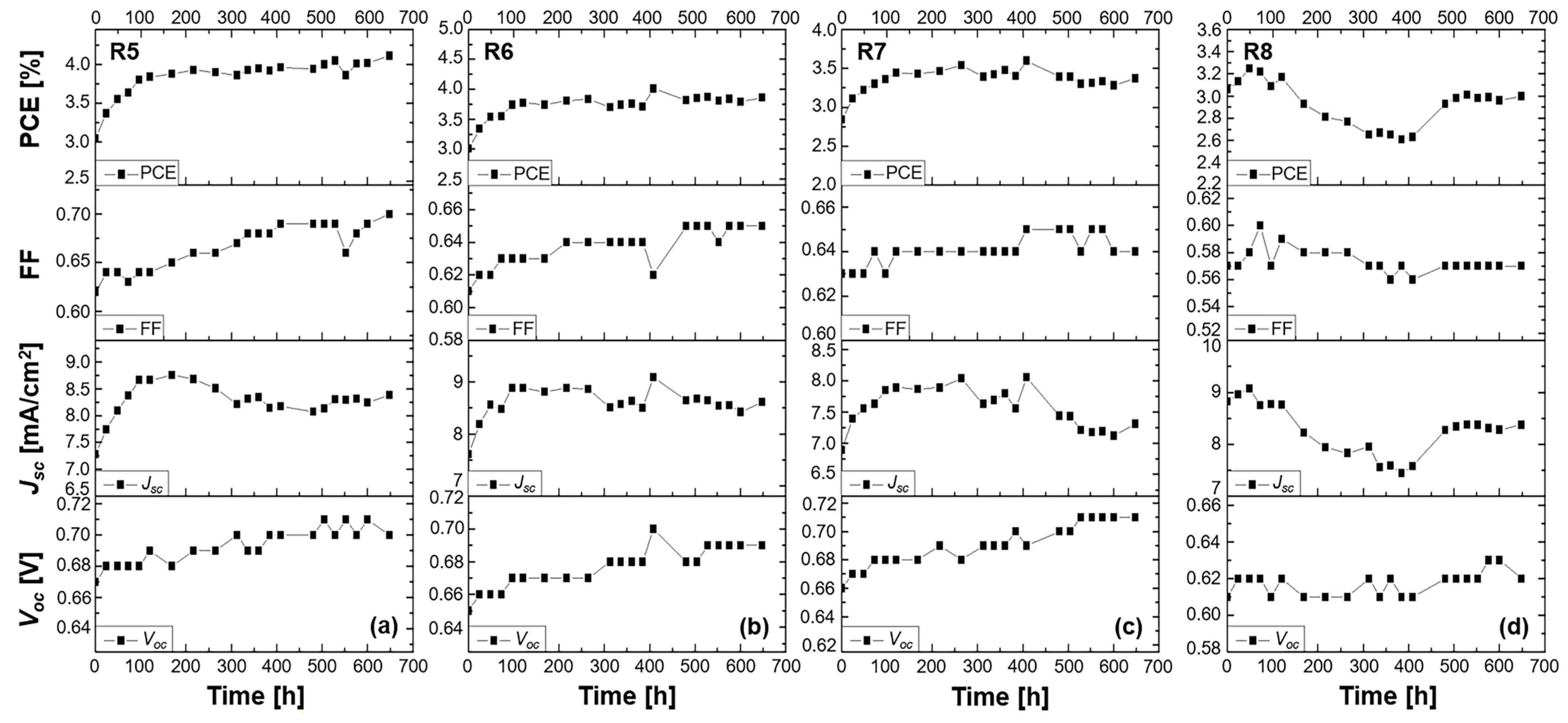

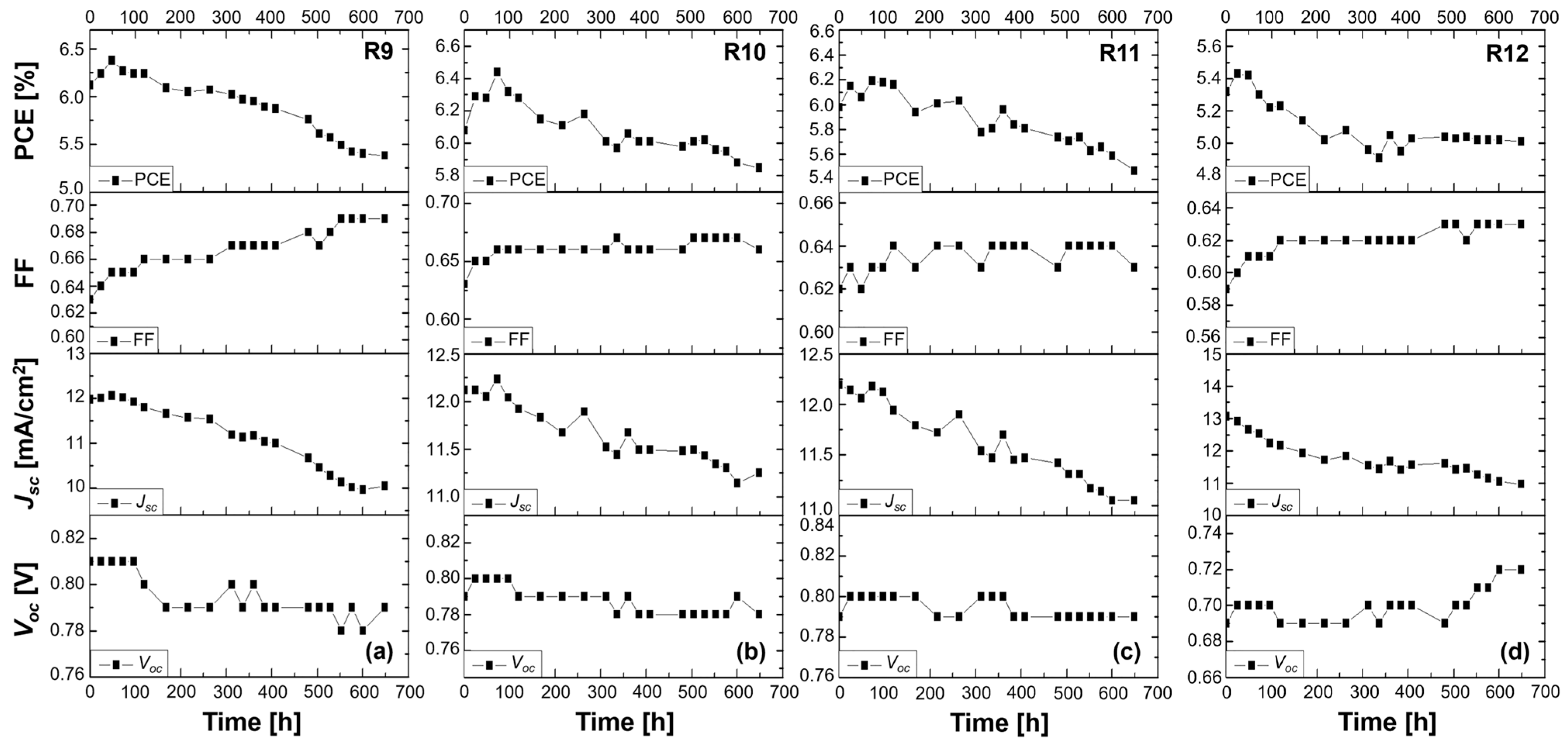
| Chemical Structure | Chemical Name |
|---|---|
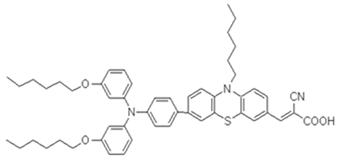 | (E)-3-(7-(4-(bis(3-(hexyloxy)phenyl)amino)phenyl)-10-hexyl-10H-phenothiazin-3-yl)-2-cyanoacrylic acid (2-LBH-100) M.W.: 822.11 g/mol |
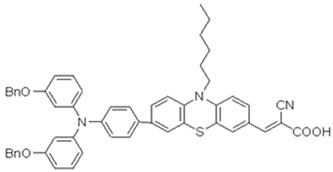 | (E)-3-(7-(4-(bis(3-(benzyloxy)phenyl)amino)phenyl)-10-hexyl-10H-phenothiazin-3-yl)-2-cyanoacrylic acid (2-LBH-44) M.W.: 834.03 g/mol |
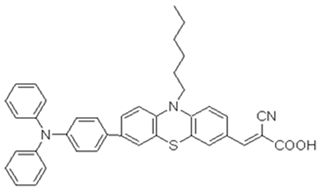 | (E)-2-cyano-3-(7-(4-(diphenylamino)phenyl)-10-hexyl-10H-phenothiazin-3-yl)acrylic acid (2-Ryu-4) M.W.: 621.79 g/mol |
| Day 1 | Day 2 | Day 3 | ||||||||||||
|---|---|---|---|---|---|---|---|---|---|---|---|---|---|---|
| Sample No. | Dye | Electrolyte | Voc [V] | Jsc [mA/cm2] | FF | PCE [%] | Voc [V] | Jsc [mA/cm2] | FF | PCE [%] | Voc [V] | Jsc [mA/cm2] | FF | PCE [%] |
| R1 R2 R3 R4 | 2-LBH-100 | D-liq. | 0.74 | 10.10 | 0.64 | 4.81 | 0.76 | 10.19 | 0.66 | 5.15 | 0.77 | 10.28 | 0.67 | 5.26 |
| PVH70 | 0.73 | 10.13 | 0.64 | 4.74 | 0.75 | 10.20 | 0.65 | 4.99 | 0.76 | 10.17 | 0.66 | 5.07 | ||
| PVH80 | 0.74 | 9.70 | 0.63 | 4.56 | 0.77 | 10.28 | 0.65 | 5.16 | 0.78 | 10.25 | 0.65 | 5.21 | ||
| PVDF-HFP | 0.66 | 10.77 | 0.59 | 4.15 | 0.66 | 10.57 | 0.61 | 4.29 | 0.66 | 10.27 | 0.60 | 4.09 | ||
| R5 R6 R7 R8 | 2-LBH-44 | D-liq. | 0.67 | 7.28 | 0.62 | 3.05 | 0.68 | 7.74 | 0.64 | 3.37 | 0.69 | 8.09 | 0.64 | 3.55 |
| PVH70 | 0.65 | 7.61 | 0.61 | 3.01 | 0.66 | 8.19 | 0.62 | 3.34 | 0.66 | 8.55 | 0.62 | 3.54 | ||
| PVH80 | 0.66 | 6.90 | 0.63 | 2.84 | 0.67 | 7.39 | 0.63 | 3.11 | 0.67 | 7.56 | 0.63 | 3.22 | ||
| PVDF-HFP | 0.61 | 8.82 | 0.57 | 3.06 | 0.61 | 9.23 | 0.58 | 3.26 | 0.62 | 9.07 | 0.58 | 3.25 | ||
| R9 R10 R11 R12 | 2-Ryu-4 | D-liq. | 0.81 | 11.98 | 0.63 | 6.12 | 0.81 | 12.01 | 0.64 | 6.24 | 0.81 | 12.06 | 0.65 | 6.38 |
| PVH70 | 0.79 | 12.12 | 0.63 | 6.08 | 0.80 | 12.11 | 0.65 | 6.29 | 0.80 | 12.04 | 0.65 | 6.28 | ||
| PVH80 | 0.79 | 12.20 | 0.62 | 5.98 | 0.80 | 12.13 | 0.63 | 6.15 | 0.80 | 12.05 | 0.62 | 6.06 | ||
| PVDF-HFP | 0.69 | 13.06 | 0.58 | 5.32 | 0.70 | 12.91 | 0.60 | 5.43 | 0.70 | 12.66 | 0.61 | 5.42 | ||
Disclaimer/Publisher’s Note: The statements, opinions and data contained in all publications are solely those of the individual author(s) and contributor(s) and not of MDPI and/or the editor(s). MDPI and/or the editor(s) disclaim responsibility for any injury to people or property resulting from any ideas, methods, instructions or products referred to in the content. |
© 2024 by the authors. Licensee MDPI, Basel, Switzerland. This article is an open access article distributed under the terms and conditions of the Creative Commons Attribution (CC BY) license (https://creativecommons.org/licenses/by/4.0/).
Share and Cite
Afre, R.A.; Ryu, K.Y.; Shin, W.S.; Pugliese, D. Exploring the Role of Donor–Acceptor Interactions in Phenothiazine Organic Dyes and Their Implications for Quasi-Solid-State Dye-Sensitized Solar Cells. Energies 2024, 17, 6466. https://doi.org/10.3390/en17246466
Afre RA, Ryu KY, Shin WS, Pugliese D. Exploring the Role of Donor–Acceptor Interactions in Phenothiazine Organic Dyes and Their Implications for Quasi-Solid-State Dye-Sensitized Solar Cells. Energies. 2024; 17(24):6466. https://doi.org/10.3390/en17246466
Chicago/Turabian StyleAfre, Rakesh A., Ka Yeon Ryu, Won Suk Shin, and Diego Pugliese. 2024. "Exploring the Role of Donor–Acceptor Interactions in Phenothiazine Organic Dyes and Their Implications for Quasi-Solid-State Dye-Sensitized Solar Cells" Energies 17, no. 24: 6466. https://doi.org/10.3390/en17246466
APA StyleAfre, R. A., Ryu, K. Y., Shin, W. S., & Pugliese, D. (2024). Exploring the Role of Donor–Acceptor Interactions in Phenothiazine Organic Dyes and Their Implications for Quasi-Solid-State Dye-Sensitized Solar Cells. Energies, 17(24), 6466. https://doi.org/10.3390/en17246466









